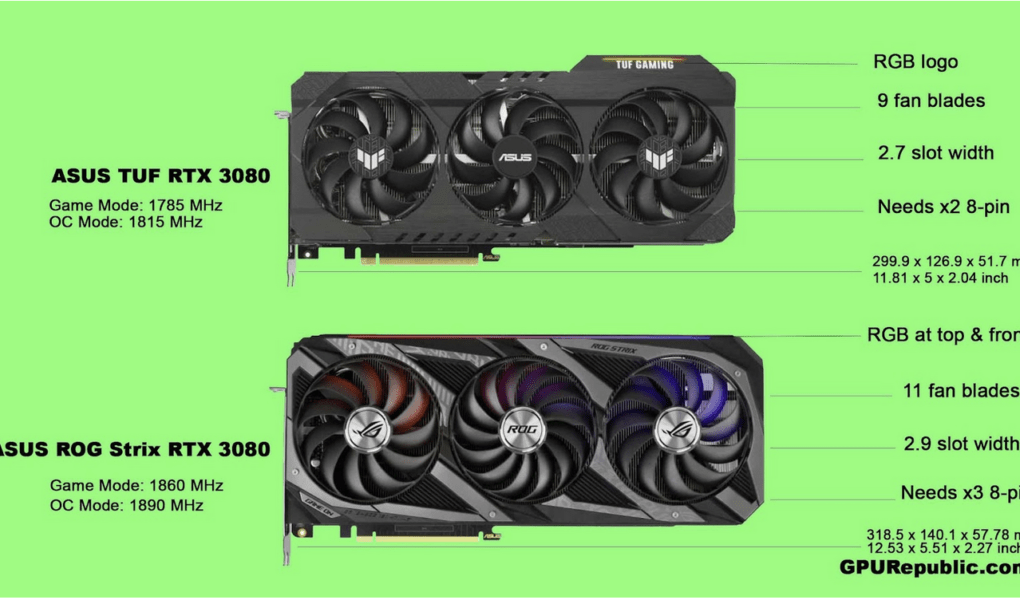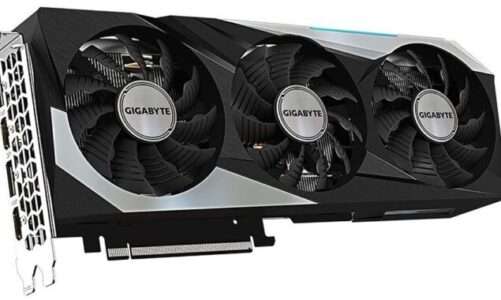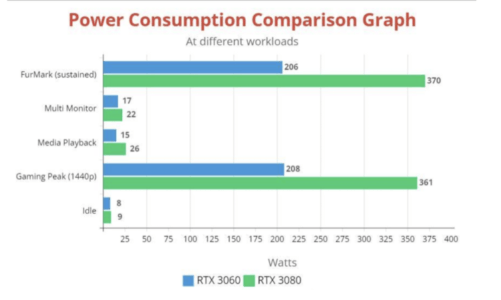Quick Navigation
GPU Republic is reader-supported. We follow a strict editorial process and put hours of research into testing, reviewing, analyzing & comparing the best products that we can find so you can make the most informed decisions. In the event you choose to buy something from one of the links on our site, we may make a commission at no extra cost to you. Whatever products we recommend, it’s because we truly believe in them, not because of the small commission we may receive. Please don’t buy any of these products unless you actually think that it would fit your needs.
ASUS ROG Strix Graphics Cards Knowledge Guide
ASUS ROG Strix cards break the clock speed barrier to bring the next level of gaming performance. ASUS has simply taken the Founder Edition cards and infused them with a high-end cooling solution to squeeze more performance out of them.
Our favorite card in the ROG Strix lineup is the ASUS ROG Strix Nvidia GeForce RTX 3080, which is equipped with three Axial-tech fans and a Game Boost clock speed of 1860 MHz to chew through the toughest workloads, but we’ll discuss this beast later on in this guide. At the moment, ASUS ROG Strix cards are expensive, but they also offer higher performance for the money.
Also, cards in the ROG Strix lineup are bulkier as compared to their Founder Edition versions, so you’ll need a spacious PC case to install them. Keep in mind that higher performance always comes at a cost. ASUS ROG Strix graphics cards are power-hungry, so you’ll need a high-wattage PSU in your build to fuel them. Some cards like the Strix GeForce RTX 3090 need up to x3 8-pin power connectors in order to run properly.
What is ASUS ROG Strix?
The ASUS Republic of Gamers (ROG) Strix lineup falls into two categories: one of them targets gaming laptops whereas the other goes for gaming graphics cards, but within both categories, the Strix series offers premium products that are tuned for maximum performance.
When talking about the graphics cards in the ROG Strix series, you should know that most of them are overclocked as soon as you take them out of the box. ASUS has customized the ROG Strix lineup with advanced backplates and high-end cooling fans for better thermal performance. We can’t forget the killer aesthetics of ROG Series cards either. Graphics cards in the ASUS ROG Strix Series have aesthetics like none other in the industry; from shrouds to backplates, everything on Strix cards is a true masterpiece.
This is the reason why chips in the ASUS ROG Strix Series are expensive compared to EVGA, MSI, and GIGABYTE, but in return for a higher price, ROG Strix cards bring solid performance to your gaming or workstation PC.
Are ROG Strix Cards Any Good?
Well, to find whether ASUS ROG cards are worth it or not. We’ll have to split every feature that ASUS offers with Strix Series graphics cards. We’ll use the ASUS ROG Strix RTX 3080 as a reference point to better understand this.
ASUS ROG Strix Design
The ASUS ROG Strix Nvidia GeForce RTX 3080 is one of the most solid-built cards with three 240mm fans in the front and an advanced backplate to handle thermals. It’s a bulky card having a width of up to 2.9 slots and it’s slightly longer than the previous generation RTX cards that are in the Strix series.
Additionally, when you put the Strix GeForce RTX 3080 side by side with some of the ASUS TUF Gaming Series cards, then you’ll find the Strix RTX 3080 beefier and glorious by all measurements. Moreover, it also has a nice touch of RGB aesthetics to it on the front and top, but to see the card in its full glory, you’ll have to install it vertically so that the fan side is facing toward the side panel of your case.
However, if you pick any other card than the RTX 3080 in the Strix lineup, you’ll find most of them identical in design. The RTX 2000 and 3000 series cards in the ROG Strix series have triple fans at the front and measure almost the same in width and length.
This means that if you are upgrading from an older Strix card to a newer one, then it would be easier for you to fit the older card inside your PC case. ASUS has customized the newer ROG Series cards with many components and this increases their overall width and length. However, if you have a spacious case, then it won’t be difficult for you to fit in these cards.
ASUS ROG Strix Performance
We have been gaming on the Strix RTX 3080 OC and it never let us down, even in 4K gameplays. ASUS has overclocked every graphics card in the Strix series to higher clock speeds, which adds some numbers to the average frame rates at the end of the day.
We know that Nvidia RTX 3080 Founder Edition is barely able to climb over 50fps in most AAA titles at 4K settings, however, with the Game Boost clock speed on Strix RTX 3080, you can easily get close to 60fps in some games. The additional clock speed and high-end cooling on Strix cards pave the road to high-end performance. Even ASUS claims that the Strix Series is better than its TUF Series if you want extra watts of performance and this is because the ROG Strix series comes with a higher TGP rating and clock speeds right out of the box.
Also, Strix offers liquid-cooled variants of some of the most powerful cards on the planet, like the Nvidia GeForce RTX 3090 Ti and AMD Radeon RX 6900 XT. The Strix RTX 3080 OC version offers 1890 MHz clock speed in Performance mode and 1860 MHz clock speed in Quiet mode. So, you are getting a huge boost in performance when compared to the non-overclocked versions that have a boost clock of 1710 MHz.
ASUS ROG Strix Power Requirements
We will not let you down, but every card in the ROG Strix needs a high-end power supply to keep the juice flowing. For instance, the Strix RTX 3080 OC requires three 8-pin power connectors and at least 850W PSU to run properly.
Even the previous generation cards like the Strix RX 560 and RX 570 require you to have at least 500W PSU in your system. As we’ve discussed earlier, performance always comes with a higher cost. ASUS has opted for high-end components to build Strix Series cards, and you’ll need a high-wattage PSU to meet the demands of those components.
According to Techpowerup, the TDP rating of ASUS Strix RTX 3080 OC can go as far as 386W under peak load. Although the triple fan system on Strix RTX 3080 OC is enough to take care of the massive heat produced, you’ll need a spacious PC case with enough vents to avoid heat buildup.
Verdict – Are Strix GPUs Worth It?
Yes, ROG Strix cards bring you higher performance in gaming and other GPU-intensive tasks. They come up with better cooling and are already overclocked to get high performance out of them, so in our opinion, if you can afford it, paying a premium to get one of the ASUS ROG Strix cards is worth it.
Who Are ASUS ROG Strix Cards Good For?
Based on the price and performance, the ROG Strix GPU lineup is meant for hardcore gaming enthusiasts. Professional content creators can also benefit from the ROG Strix cards, but extra clock speed and fancy aesthetics have little to do with productivity tasks.
They are meant for users who do not have any strict budget limitations to their dream cards. Additionally, the GPUs’ RGB aesthetics and high performance make Strix cards a ready-to-go deal for high-end gaming PCs. ASUS ROG Strix is probably a no-go for budget gamers and those willing to spend less. If you don’t want to put a hole in your wallet, then it’s better to look for a cheaper graphics card.
Strix graphics cards are a premium product, and their higher price tag is justified by the great design, decent aesthetics, tremendous cooling, and overclocking performance. In reality, you are paying for better thermal ability of the card, higher default clock speed, and above all, eye-catching aesthetics. All of these factors mean a lot for hardcore gamers who are building a dream gaming machine. If you’re not worried about shelling out for a more expensive GPU and all you need is a graphics card tuned for high-end performance out of the box, then the ROG Strix lineup has a lot to offer.
Comparing The Most Popular ASUS ROG Strix Graphics Cards & Their Specs
Although the higher-end cards in the Strix lineup look similar in shape, they end up delivering different performances in gaming. Here are the top cards in the ROG Strix series if you’re looking to buy:
ASUS ROG Strix Nvidia GeForce RTX 3090 24GB
Although the Founders Edition of the RTX 3090 is way more powerful than many previous generations’ overclocked cards, ASUS has made much-needed improvements to this card in the ROG Strix lineup.
There’s more metal that surrounds this card this time resulting in better thermal performance and like most high-end cards in the ROG Strix series, there are three big 280mm radiators at the front to dissipate the enormous heat generated. Just below the fan blades, there’s an advanced heatsink to take care of the thermal load. Also, addressable RGB lights are glowing beneath the fans that you can adjust according to your flavor and preferred style.
There are much better aesthetics on this RTX 3090 than you’ll find on any other card in the market. ASUS has overclocked the Strix RTX 3090 with 1890 MHz OC and 1860 Game Boost clock speed. It’s a significant jump from the boost clock speed that you’ll find on the Founders Ecition variant of this card.
The rest of the specs remain the same, there’s 24GB of GDDR6X memory, 10496 CUDA cores, and up to 4 video outputs to connect multiple monitors to this card. If you want to witness the power of an overclocked version of RTX 3090 in 4K or 8K gaming, then the Strix RTX 3090 would put you ahead of any card in the market.
ASUS ROG Strix Nvidia GeForce RTX 3080 12GB
We’ve already praised the Strix RTX 3080 in this guide and it’s because we had one of these pieces in our gaming lab and it was outstanding across the board. Just like the Strix RTX 3090, the RTX Strix 3080 is covered in shrouds and 280mm fans at the front.
The axial-fan design results in optimal airflow to cool down this powerful card at peak loads. The heatsink under the fans has increased in size, which results in allocating a 2.9 slot width to this card. This ultimately means that there’s more surface area left for heat to spread and dissipate.
Like many other cards in the ASUS ROG Strix Series, the RTX 3080 is made up of high-quality chokes, MOSFETs, and capacitors to enhance its life span. The design and RGB aesthetics on this card are pretty much the same that we see on the RTX 3090 model and it needs the same amount of power connectors and PSU to run as the RTX 3090 does.
The only difference between them comes down to the basic specifications that both cards have to offer. The Strix RTX 3080 has half the amount of VRAM (12GB) compared to the Strix RTX 3090. Also, the CUDA core count on RTX 3080 is less than that of the RTX 3090, but the assigned game (1860MHz) and OC (1890MHz) clock speed on both cards remains the same.
Lastly, the Strix RTX 3080 is cheaper compared to the RTX 3090 model and the falling prices of GPUs all over the globe have brought down the Strix RTX 3080 to under $800. It’s a great card for playing 4K games, especially because ASUS has boosted this card with extra clock speed as soon as you unbox it.
ROG Strix AMD Radeon RX 6750 XT OC Edition
The Strix Radeon RX 6750 XT is infused with the same cooling components and shrouds that we have on the RTX 3080 and RTX 3090. If you put this card side by side with the RTX 3080 and the RTX 3090, then the design and aesthetics look the same from the front and sides. But ASUS has enhanced the Radeon RX 6750 XT with more boost clocks speeds than the previous two cards on the list.
Right out of the box, you are welcomed by a Game Clock Speed of 2623MHz and an OC Clock Speed of 26463MHz. On paper, it looks like the RX 6750 XT would win the race over the RTX 3080 and RTX 3090, but you’d be mistaken!
The extra clock speed attributed to the RX 6750 XT does bring it closer in performance to the Strix RTX 3090, but it remains far away from surpassing the RTX 3090 in 4K gaming due to its less VRAM and memory bandwidth. Despite attributing higher speeds to this graphics card, ASUS has cut down the power requirements to x2 8-pin power connectors. For this GPU you’ll only need a 750W PSU to run it instead of 850W that you need for the RTX 3080 and RTX 3090. It’s yet another 2.9 slot card in the ASUS Strix lineup that takes advantage of its extra boost clock speed to let you play most games at 4K settings.
ROG Strix AMD Radeon RX 6650 XT
The ASUS ROG Strix RX 6650 XT enjoys the same comforts just like its elder brother, the Strix RX 6750 XT, but instead of three fans, there are only two axial fans on this graphics card. This also trims down the length of the graphics and heatsink, lowering the overall power requirements. Instead of two 8-pin connectors, it only needs a single 8-pin power connection from your PSU.
Moreover, you can simply run this graphics card with a 650W power supply. So, if you already have 650W or higher PSU, you can just pop in this card right away in your build. Just like the Strix RX 6750 XT, the Strix RX 6650 XT enjoys the higher clock speeds offered by ASUS. It comes with an OC Clock Speed of 2694MHz and a Game Clock Speed of 2523 MHz to put a cover on its weaker 128-bit memory interface side.
The overclock speed does help this card to steal the 1080p gaming show, but its 8GB VRAM, 17.5 Mbps bandwidth, and 2048 processing cores restrict it from breaking the 1440p barrier and entering into the 4K gaming world.
ROG Strix Nvidia GeForce RTX 3050
If you ever wish the RTX 3050 to push the performance boundaries, then you should look for it in the ROG Strix lineup. Although there are other brands like GIGABYTE and MSI that have tuned this card to get the most out of it, we believe that ASUS has done all of this in the best manner.
Again and again, the main design remains the same as it does on the other Strix cards, but with 2.7 slots instead of 2.9, it’s one of the slimer cards that you’ll find in the Strix lineup when you compare all the options. It needs less power than the Strix Radeon RX 6560 XT and can easily work with a 550W PSU. However, both cards will need a single 8-pin power connection from the PSU.
There are three powerful cooling fans at the front to keep this card cool under heavy workloads and there is an adjustable RGB lights tune to match it with the rest of your rig. The Strix RTX 3050 has the same amount of video memory as the Strix Radeon RX 6650 XT, but is helped by Nvidia’s Ampere architecture to unleash the best performance in 1080p gaming.
To get extra wattage out of it, ASUS has assigned 1807MHz OC and 1777 Game Clock Speed to this graphics card and although this is way less than what ASUS has provided to the Strix Radeon RX 6650 XT, the performance of both cards is identical under 1080p gaming workloads.
ASUS ROG Strix VS TUF – How Do They Compare?
On paper, both the TUF and Strix series cards are meant for the gaming enthusiast who wants to get the most bang for their buck. Both series offer higher stock clock speeds and better cooling to squeeze out more performance, but technically, there’s a little more that ROG Strix puts on your desk that ASUS TUF doesn’t.
For example, if we pick the same model card from both the Strix and TUF series and put them side by side, you’ll see a lot of differences in design and aesthetics. Also, the model that belongs to the Strix Series will offer slightly better clock speed than the TUF model.
We have compared the same RTX 3080s from ASUS TUF and ROG Strix, it’s clear that the Strix version has better looks and more power to it. In the TUF series, the RTX 3080 has a maximum boost clock speed of up to 1815 MHz, whereas in the Strix lineup, the RTX 3080 jumped up from 1860 MHz up to 1890 MHz.
The Strix version of the RTX 3080 will give you a slight edge in performance over the TUF version and will give you more freedom to customize RGBs on the top shroud and even in the front where we have the three axial fans. Compare this to the TUF version, where you only have the illuminating TUF logo rather than the whole scheme to update to your liking.
ASUS has also increased the number of blades on the axial fans found in the Strix cards. TUF series graphics card comes with axial fans with 9 blades, however the Strix card comes with 11 fan blades on all the axial fans present on the front. This is more efficient and results in more cooling while consuming less power.
Strix cards are bulky and consume up to 2.9 slots on your motherboard, so you’ll need a spacious PC case to accommodate a Strix card. TUF cards consume a bit less space (2.7 slots) compared to the Strix card. Also, TUF cards consume less power as compared to their Stix variants. The Strix RTX 3080 needs three 8-pin power connections. The same card in the TUF series only needs two 8-pin connections from your PSU.
All in all, the ASUS ROG Strix graphics cards offer plenty of performance to value-oriented gamers. They are expensive and draw more energy out of your PSU, but they promise high-end gaming performance at the end of the day.

Hi, I’m the author and founder of this blog. I have more than 10 years of experience in the industry. Throughout my journey I’ve tested and reviewed hundreds of graphics card for custom PC builds. I believe my knowledge and experience will help you choose the card that really falls to your needs and budget.



